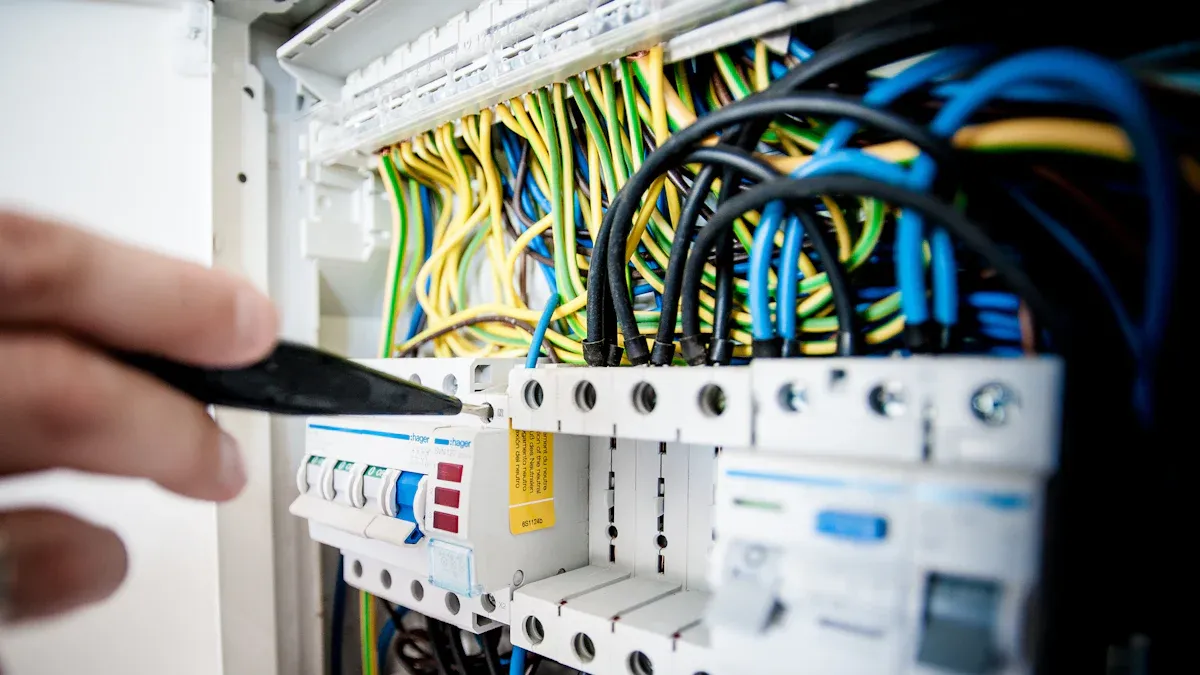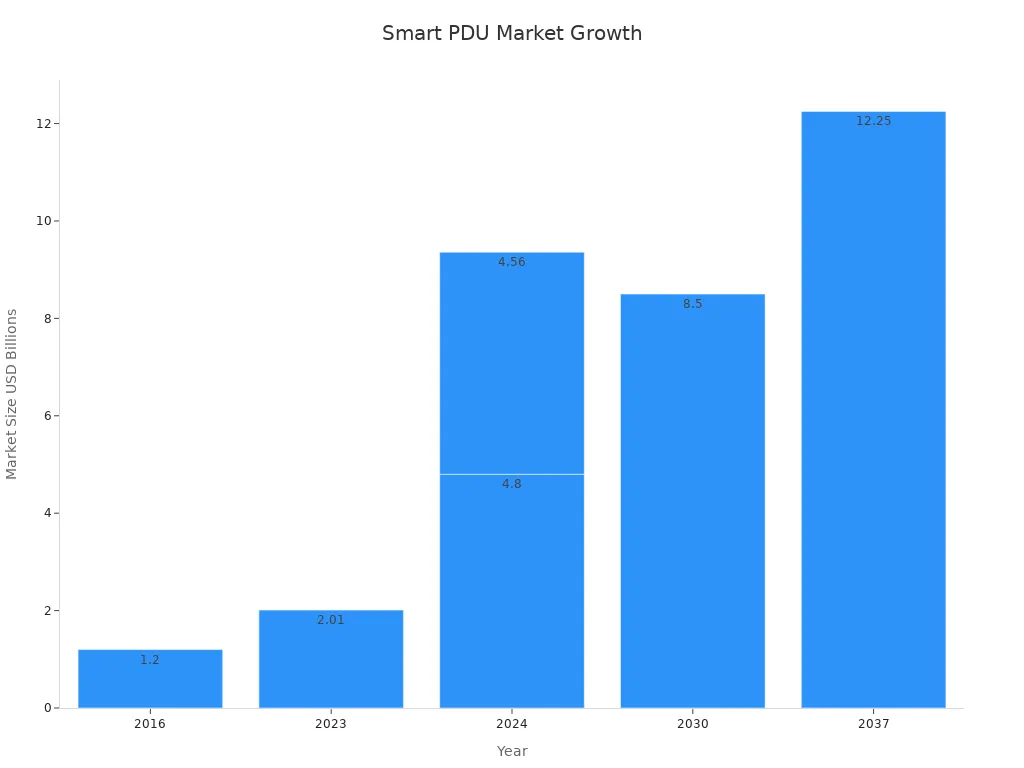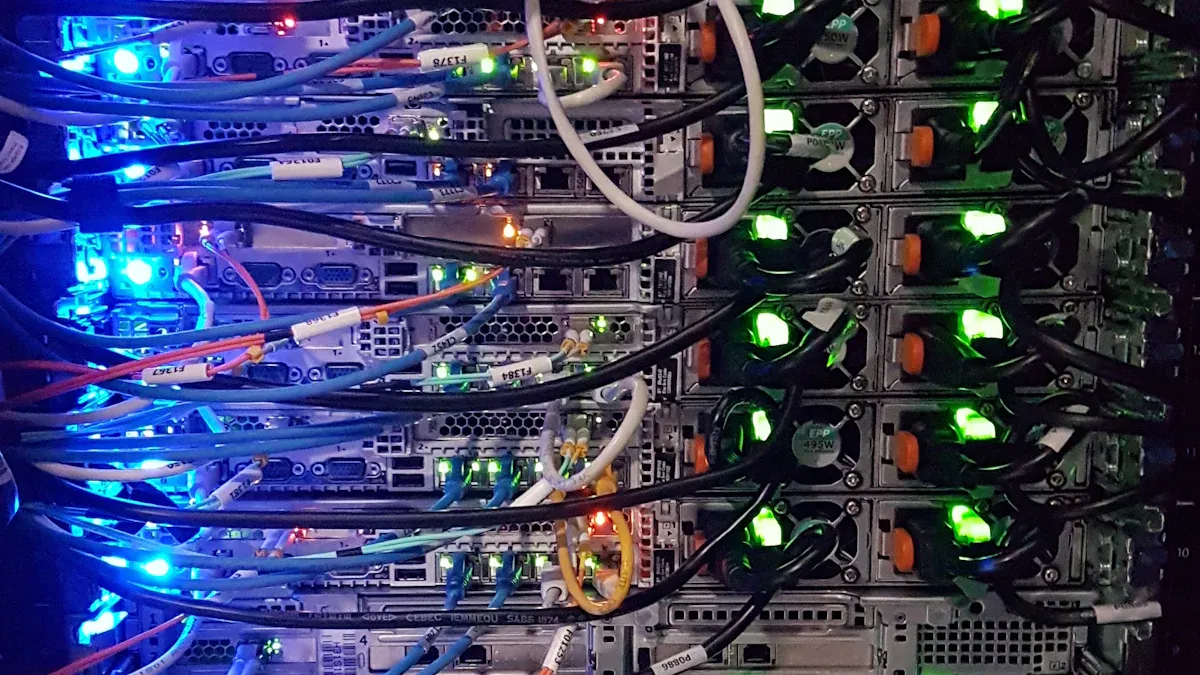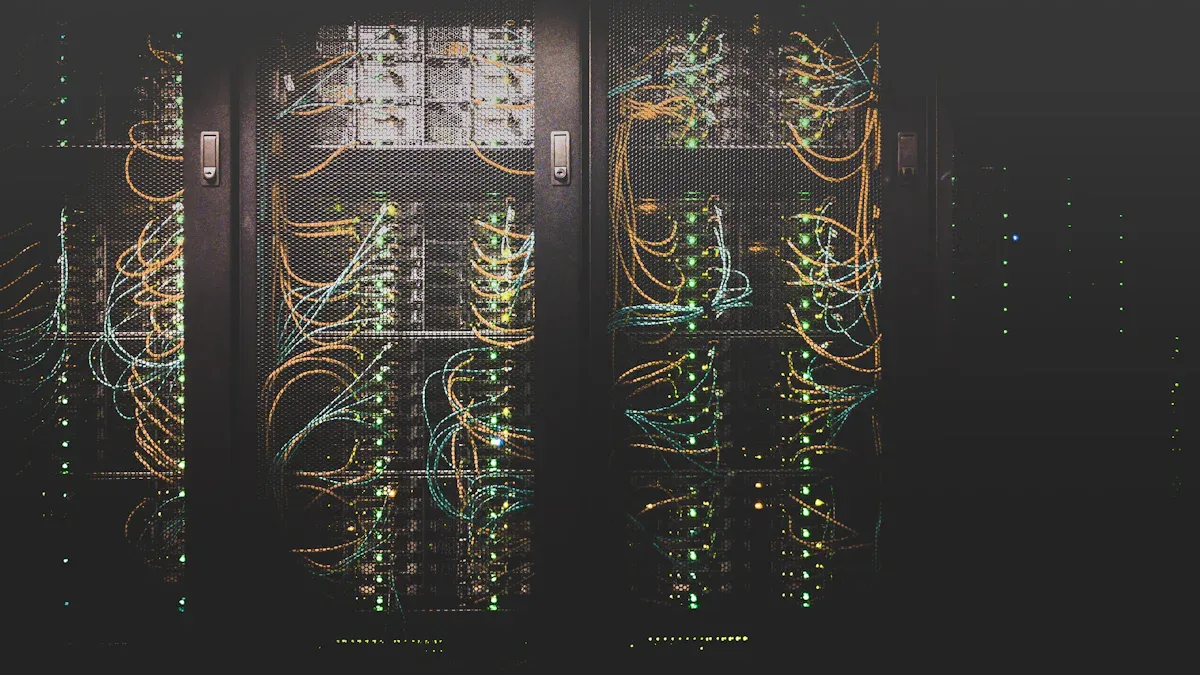
Smart power distribution units are reshaping how businesses approach energy management. These devices enable real-time energy tracking, allowing companies to identify inefficiencies and reduce power waste by up to 30%. By improving energy usage, smart PDUs not only cut operational costs but also support sustainability initiatives, making them indispensable for modern enterprises.
Key Takeaways
- Smart PDUs can cut energy waste by 30%. This helps businesses save money and protect the environment.
- Live monitoring and remote controls help use energy better. They also stop equipment from breaking, making systems more reliable.
- Connecting smart PDUs to energy systems makes them work best. It allows central tracking and better energy sharing for more efficiency.
Understanding Smart Power Distribution Units
Key Features of Smart Power Distribution Units
Smart power distribution units are equipped with advanced features that redefine energy management. These devices provide real-time monitoring of power consumption, enabling businesses to identify inefficiencies and optimize energy usage. Remote control capabilities allow users to manage power loads from any location, reducing the need for on-site intervention. Additionally, integrated environmental sensors monitor temperature, humidity, and airflow, ensuring equipment operates within safe parameters.
The scalability of these units makes them ideal for growing businesses. Modular designs and flexible configurations adapt to expanding data center needs, ensuring seamless integration with existing infrastructure. Reliability is another key feature, as smart PDUs monitor power parameters to prevent equipment failures and downtime.
| Feature | Description |
|---|---|
| Advanced Power Management | Enables real-time monitoring of power consumption, providing insights into energy patterns. |
| Remote Control | Allows management of power loads from any location, reducing the need for on-site intervention. |
| Reliability | Monitors power parameters and environmental conditions to prevent equipment failures. |
| Scalability | Adapts to growing data center needs with modular designs and flexible configurations. |
Differences Between Smart and Traditional PDUs
Smart power distribution units offer significant advantages over traditional PDUs. While traditional PDUs provide basic power distribution, smart PDUs excel in real-time monitoring, remote management, and environmental oversight. They integrate advanced features such as alerts for overload prevention and detailed reporting on energy consumption, making them indispensable for high-density environments like data centers.
| Feature | Traditional PDUs | Smart PDUs |
|---|---|---|
| Monitoring | No monitoring capabilities | Real-time monitoring of power consumption |
| Remote Management | Manual control only | Remote control and automation available |
| Environmental Sensors | Absent | Integrated sensors for temperature, humidity, and airflow |
| Alerts | None | Alerts for overload prevention |
| Energy Efficiency | Basic power distribution | Advanced power management capabilities |
| Reporting | No reporting features | Detailed reporting on energy consumption |
| Ideal Use Case | Low-density environments | High-density environments like data centers |

Smart PDUs also support sustainability goals by enabling businesses to reduce energy waste. Their ability to provide actionable insights into energy usage makes them a superior choice for modern enterprises.
Enhancing Energy Efficiency with Smart Power Distribution Units
Intelligent Load Management to Reduce Energy Waste
Smart power distribution units play a pivotal role in reducing energy waste through intelligent load management. By analyzing energy consumption patterns, these devices identify underutilized equipment and redistribute power more effectively. This ensures that energy is allocated only where it is needed, minimizing unnecessary consumption.
For example, a manufacturing facility utilized intelligent load management to monitor peak load contributions and reduce overall energy consumption. This approach saved the facility over $131,000 in energy costs annually. Similarly, a global building materials company implemented load management across 42 sites, achieving significant annual savings while enhancing operational efficiency.
| Case Study Description | Outcome |
|---|---|
| A medical provider planned their Demand Response curtailment strategy and shed 3.5 MW during an event. | 3.5 MW reduction in energy usage |
| A manufacturing facility reduced consumption and managed peak loads with PowerRadar. | $131k savings in energy costs |
| A building materials giant optimized energy use at 42 sites. | Significant annual savings |
These examples highlight how intelligent load management not only reduces energy waste but also delivers measurable financial benefits.
Automation and Scheduling for Optimized Power Usage
Automation and scheduling features in smart power distribution units enable businesses to optimize power usage effortlessly. By automating routine tasks, such as powering down idle equipment or scheduling energy-intensive operations during off-peak hours, organizations can achieve substantial energy savings.
Google’s AI-powered data centers exemplify the potential of automation. By optimizing cooling systems, these centers reduced energy consumption by over 40%. Similarly, IBM’s smart grid optimization prevented blackouts and improved reliability by predicting energy demand and balancing grid loads. These real-world applications demonstrate how automation and scheduling can transform energy management.
Smart power distribution units also allow users to create customized schedules for specific devices or systems. This ensures that energy is used efficiently, even in complex environments like data centers or manufacturing facilities. The ability to automate and schedule power usage not only reduces operational costs but also supports sustainability initiatives.
Energy-Saving Features That Lower Costs
Smart power distribution units come equipped with energy-saving features designed to lower operational costs. These include real-time monitoring, proactive alerts, and detailed reporting on energy consumption. By providing actionable insights, these features help businesses identify inefficiencies and implement corrective measures.
In real-world deployments, smart power distribution units have demonstrated significant energy efficiency improvements. For instance, organizations reported an 18% reduction in power consumption, resulting in annual savings of approximately $120,000. Proactive alerts for circuit overloads also minimized downtime and extended equipment lifespan, further enhancing cost efficiency.
Tip: Investing in smart power distribution units not only reduces energy costs but also improves the reliability of critical systems. This makes them an invaluable asset for businesses aiming to enhance operational efficiency.
By integrating these energy-saving features, smart power distribution units empower businesses to achieve their energy efficiency goals while maintaining high levels of performance and reliability.
Real-Time Energy Monitoring with Smart Power Distribution Units

Device-Level Energy Consumption Tracking
Smart power distribution units enable precise tracking of energy consumption at the device level. This granular monitoring provides businesses with a clear understanding of how individual devices or systems consume power. By identifying high-energy-consuming equipment, organizations can implement targeted strategies to reduce waste and improve efficiency.
For instance, a data center can monitor the energy usage of each server rack. This allows the identification of underperforming or overburdened servers, which can then be optimized or replaced. Similarly, in manufacturing facilities, tracking the energy consumption of specific machinery helps pinpoint inefficiencies and prioritize maintenance efforts. These insights empower businesses to make informed decisions that enhance operational efficiency and reduce costs.
Tip: Device-level tracking not only improves energy efficiency but also supports sustainability goals by reducing unnecessary power consumption.
Data Insights for Predictive Maintenance
Predictive maintenance has become a cornerstone of modern energy management, and smart power distribution units play a pivotal role in this transformation. These units collect and analyze real-time data, enabling businesses to monitor equipment health and predict potential failures before they occur. This approach minimizes unplanned downtime and extends the lifespan of critical systems.
Industries such as manufacturing, healthcare, and telecommunications have widely adopted predictive maintenance strategies. Intelligent power distribution units enhance this process by offering advanced functionalities, including energy metering, environmental monitoring, and automated alerts for potential issues. They also integrate AI and machine learning to analyze power usage trends and detect anomalies, facilitating a shift from reactive to proactive maintenance.
- Benefits of predictive maintenance with smart power distribution units:
- Reduced need for scheduled maintenance.
- Enhanced equipment reliability and uptime.
- Lower operational costs through early issue detection.
By leveraging these data-driven insights, businesses can optimize their maintenance schedules and ensure uninterrupted operations.
Alerts and Reports for Proactive Energy Management
Proactive energy management relies on timely alerts and comprehensive reporting, both of which are integral features of smart power distribution units. These devices generate real-time notifications for critical events, such as power overloads or environmental changes, allowing businesses to address issues promptly. Detailed reports on energy consumption trends further support long-term planning and optimization.
For example, a smart power distribution unit can send an alert when a circuit approaches its maximum capacity. This enables immediate action to prevent potential outages or equipment damage. Additionally, periodic reports provide valuable insights into energy usage patterns, helping organizations identify inefficiencies and implement corrective measures.
Note: Automated alerts and detailed reporting not only improve energy efficiency but also enhance the reliability of critical systems, making them indispensable for modern enterprises.
By combining real-time monitoring, predictive maintenance, and proactive management, smart power distribution units revolutionize how businesses approach energy efficiency and operational reliability.
Practical Applications of Smart Power Distribution Units

Data Centers: Improving Efficiency and Reducing Costs
Data centers rely heavily on smart power distribution units to enhance efficiency and minimize operational costs. These units provide real-time monitoring, enabling IT teams to identify inefficiencies and optimize energy usage. For instance, PDUs with high-efficiency transformers improve energy efficiency by 2% to 3%, which significantly reduces power waste. Additionally, powering down two unloaded 300 kVA PDUs saved Target 261,000 kWh annually, demonstrating the financial benefits of intelligent power management.
Smart PDUs also mitigate downtime risks, which is critical in environments where outages can cost over $100,000 per hour. By integrating features like remote management and proactive alerts, these devices ensure uninterrupted performance. Newsunn’s PDUs, for example, have helped mid-sized data centers reduce energy consumption by up to 20%, translating to annual savings of $50,000. As the PDU market grows from $2.1 billion in 2023 to over $3 billion by 2028, their role in data centers will only become more indispensable.
Manufacturing: Streamlining Operations and Saving Energy
In manufacturing, smart power distribution units streamline operations by optimizing energy management. Real-time monitoring prevents downtime by identifying potential issues before they escalate. Remote management capabilities further enhance efficiency by reducing the need for on-site interventions. For example, companies like eBay have cut operational costs by 50% through the strategic use of smart PDUs.
| Feature/Benefit | Evidence/Impact |
|---|---|
| Energy Savings | Up to 20% reduction in energy bills |
| Operational Cost Reduction | Companies like eBay cut costs by 50% |
| Real-time Monitoring | Prevents downtime and ensures operations |
| Remote Management | Reduces need for on-site visits |
| Environmental Protection | Supports eco-friendly goals |
By supporting eco-friendly initiatives and reducing energy bills, smart PDUs empower manufacturers to achieve both financial and environmental goals.
Office Spaces: Supporting Green Initiatives and Sustainability
Office spaces increasingly adopt smart power distribution units to support green initiatives and sustainability goals. These units enable precise energy monitoring, helping organizations reduce waste and transition to more efficient power systems. For example, J.R. Simplot’s data center refurbishment included intelligent rack PDUs and energy management software, which improved energy efficiency and environmental monitoring.
Key features like outlet-level power metering and environmental sensors allow businesses to optimize power usage while maintaining operational reliability. By transitioning to higher voltage systems and increasing rack density, organizations can achieve significant energy savings. These efforts not only lower operational costs but also align with corporate sustainability objectives, making smart PDUs a vital tool for modern office environments.
Steps to Implement Smart Power Distribution Units
Evaluating Your Current Power Distribution Needs
The first step in implementing a smart power distribution unit is to assess your current power distribution requirements. Begin by identifying the total power demand and the type of input power needed, whether AC or DC. Evaluate the number of devices requiring power and consider future expansion by selecting a PDU with more outlets than currently necessary. Additionally, ensure the outlet types match the plugs used by your equipment.
When planning your budget, consider the long-term benefits of smart PDUs. Although they may have a higher initial cost, their advanced features, such as real-time monitoring and remote management, can lead to significant savings over time. These devices reduce energy waste, minimize downtime, and enhance operational efficiency, ultimately saving thousands of dollars annually.
Selecting the Right Smart PDU for Your Business
Choosing the right smart PDU involves analyzing several key factors. The table below outlines critical decision criteria:
| Factor | Description |
|---|---|
| Power Source and Rating | Ensure compatibility with your input power type and total power demand. |
| Number of Outlets | Choose a PDU with sufficient outlets to meet current and future needs. |
| Outlet Types | Match the outlet types to the plugs used by your devices. |
| Additional Features | Determine if advanced monitoring and control features are necessary. |
Advanced features like remote control, real-time monitoring, and energy-saving modes further enhance operational efficiency. For example, intelligent PDUs can track energy consumption at the outlet level, identify inefficiencies, and automatically shut down inactive outlets to reduce unnecessary energy usage.
Integrating Smart PDUs with Energy Management Systems
Integrating smart PDUs with energy management systems (EMS) maximizes their potential. These units can connect seamlessly with Data Center Infrastructure Management (DCIM) software, providing a centralized view of power usage. This integration enables businesses to monitor energy consumption, enhance load balancing, and streamline operations.
For example, a manufacturing facility integrated smart PDUs with its EMS to monitor energy usage across multiple sites. This approach improved load distribution and reduced energy waste, resulting in significant cost savings. By leveraging such integration models, businesses can achieve greater control over their energy management strategies.
Tip: Ensure compatibility between your smart PDU and existing EMS software to unlock the full potential of these devices.
Smart power distribution units are reshaping energy management by offering advanced tools for monitoring, optimization, and control. Recent reports highlight a projected $24.05 billion growth in the data center power market by 2029, driven by the demand for energy-efficient solutions. Businesses adopting these units reduce energy waste, lower costs, and achieve sustainability goals, ensuring competitiveness in an energy-conscious world.
FAQ
What industries benefit the most from smart PDUs?
Industries like data centers, manufacturing, and healthcare gain the most from smart PDUs. These sectors require precise energy management, operational efficiency, and reduced downtime to maintain productivity.
How do smart PDUs support sustainability goals?
Smart PDUs reduce energy waste through real-time monitoring and intelligent load management. These features help businesses lower their carbon footprint and align with eco-friendly initiatives.
Can smart PDUs integrate with existing energy management systems?
Yes, smart PDUs integrate seamlessly with energy management systems. This compatibility enables centralized monitoring, improved load balancing, and streamlined energy optimization across facilities.
Tip: Consult your PDU supplier to ensure compatibility with your current energy management software for maximum efficiency.
Post time: Jun-03-2025


